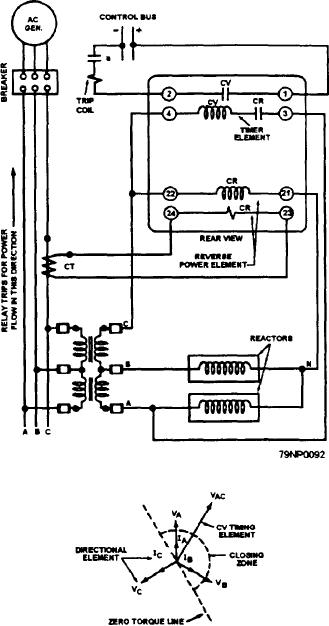
by these two quantities cause rotation of the disk in a
direction depending upon the phase angle between the
current and voltage. If the line power reverses, the
current through the relay current coils will reverse with
respect to the polarizing voltage and provide a
directional torque.
The contact assembly and permanent magnet
construction are the same as that used for the timer
element. The timer element is rated at 115 volts, 60
hertz. The minimum timer element trip voltage is 65
volts, and its continuous rating is 127 volts.
The direction element has a power characteristic
such that, when the current and voltage are in phase,
maximum torque is developed. The potential coil is
rated at 70 volts, 60 hertz.
The current coil rating is 5 amperes, and the
minimum pickup current is 0.1 ampere through the coil.
This current is in phase with 65 volts (minimum) across
the potential coil. These are minimum trip values, and
the timing characteristic of the timing relay may be
erratic with low values.
For maximum protection and correct operation,
unity power factor on the system. Because the
directional element has power characteristics, make the
connection by using line to neutral voltage for the
directional element potential coil (polarizing voltage)
and the corresponding line current in the series coils. If
a neutral is not available, you can obtain a dummy
neutral by connecting two reactors, as shown in figure
2-45. When connected in this manner, the directional
element voltage coil forms one leg of a wye connection,
and the reactors form the other two legs of the wye.
Connect the voltage-operated timer element across the
outside legs of the transformer secondaries.
Figure 2-45.--Schematic wiring diagram of an ac
reverse-power relay.
REVERSE-CURRENT RELAY
The reverse-current relay connections are such that
when the reverse power reaches a definite percentage of
Two or more dc generators may be connected in
the rated power output, it will trip the generator circuit
parallel to supply sufficient power to a circuit. Each dc
breaker, disconnecting the generator from the line.
generator is driven by its own prime mover. If one prime
Normally, the reverse-current settings for dc relays are
mover fails, its generator will slow down and draw
about 5 percent of rated generator capacity for dc
power from the line. The generator will then operate as
generators.
a motor, and instead of furnishing power to the line, it
The reverse-current relay (one for each generator)
will draw power from the line. This can result in
is located on the generator switchboard and is an integral
damage to the prime mover and overloading of the
generator. To guard against this possibility, use
part of the circuit breaker. The mechanical construction
reverse-current relays.
of a dc relay designed to limit reverse-current flow is
2-39

